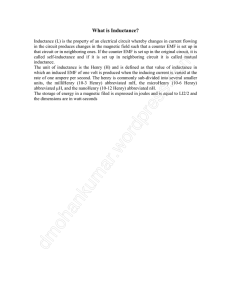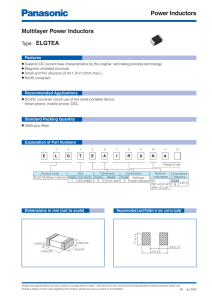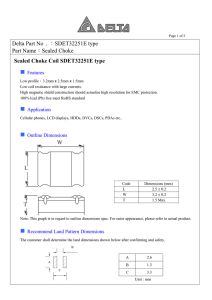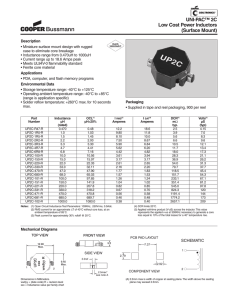Mutual and Self Inductance
advertisement
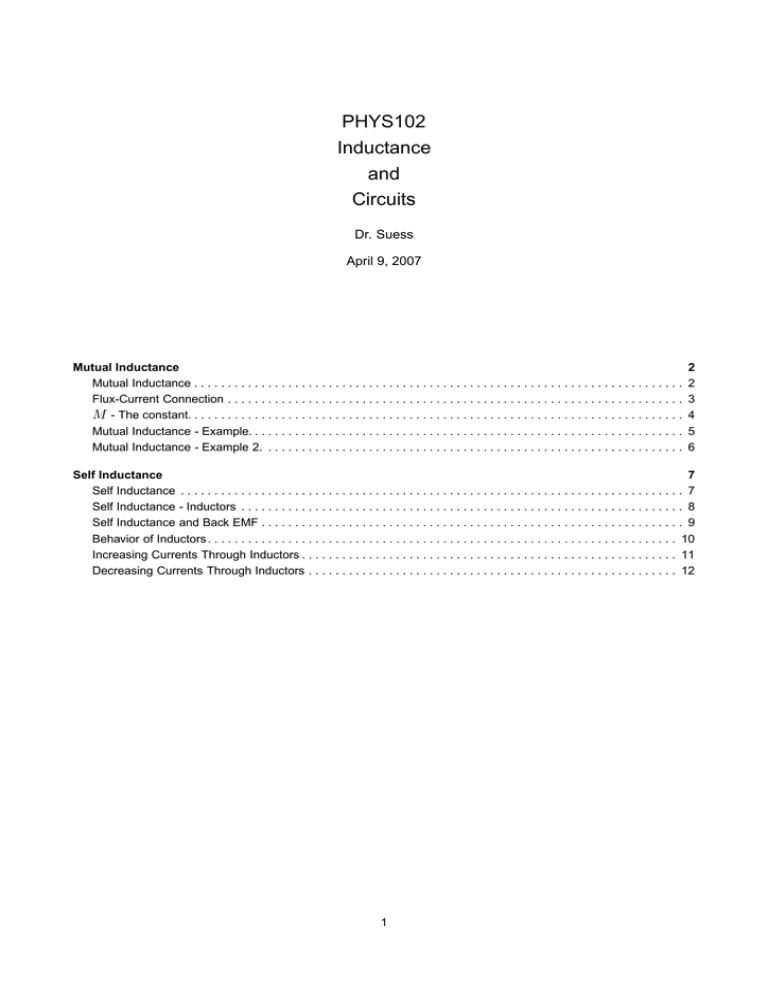
PHYS102 Inductance and Circuits Dr. Suess April 9, 2007 Mutual Inductance Mutual Inductance . . . . . . . . . . . . . . . . . . . . . . . . . . . . . . . . . . . . . . . . . . . . . . . . . . . . . . . . . . . . . . . . . . . . . . . . . Flux-Current Connection . . . . . . . . . . . . . . . . . . . . . . . . . . . . . . . . . . . . . . . . . . . . . . . . . . . . . . . . . . . . . . . . . . . . M - The constant. . . . . . . . . . . . . . . . . . . . . . . . . . . . . . . . . . . . . . . . . . . . . . . . . . . . . . . . . . . . . . . . . . . . . . . . . . Mutual Inductance - Example. . . . . . . . . . . . . . . . . . . . . . . . . . . . . . . . . . . . . . . . . . . . . . . . . . . . . . . . . . . . . . . . . Mutual Inductance - Example 2. . . . . . . . . . . . . . . . . . . . . . . . . . . . . . . . . . . . . . . . . . . . . . . . . . . . . . . . . . . . . . . 2 2 3 4 5 6 Self Inductance 7 Self Inductance . . . . . . . . . . . . . . . . . . . . . . . . . . . . . . . . . . . . . . . . . . . . . . . . . . . . . . . . . . . . . . . . . . . . . . . . . . . 7 Self Inductance - Inductors . . . . . . . . . . . . . . . . . . . . . . . . . . . . . . . . . . . . . . . . . . . . . . . . . . . . . . . . . . . . . . . . . . 8 Self Inductance and Back EMF . . . . . . . . . . . . . . . . . . . . . . . . . . . . . . . . . . . . . . . . . . . . . . . . . . . . . . . . . . . . . . . 9 Behavior of Inductors . . . . . . . . . . . . . . . . . . . . . . . . . . . . . . . . . . . . . . . . . . . . . . . . . . . . . . . . . . . . . . . . . . . . . . 10 Increasing Currents Through Inductors . . . . . . . . . . . . . . . . . . . . . . . . . . . . . . . . . . . . . . . . . . . . . . . . . . . . . . . . 11 Decreasing Currents Through Inductors . . . . . . . . . . . . . . . . . . . . . . . . . . . . . . . . . . . . . . . . . . . . . . . . . . . . . . . 12 1 Mutual Inductance slide 2 0.1 Definition Mutual Inductance • I hope we are all comfortable finding the magnetic flux through various closed loops. • Let’s consider the following situation of two circular coils placed near each other as shown in the figure below. • Coil 1 has current passing through it (provided by an external battery) and coil 2 is NOT connected to any battery source. ◦ Φ2 ∝ I1 PHYS102 Inductance – slide 2 Flux-Current Connection • Φ2 ∝ I1 • Φ2 = M2,1 I1 where M2,1 is a constant of proportionality (called Mutual Inductance). • If the current in circular loop 1 varies, then by Faraday’s Law of Induction: ε2 = − d Φ2 dt ε2 = −M2,1 d I1 dt is the induced EMF in the circular loop 2. PHYS102 Inductance – slide 3 2 M - The constant. • The S.I. Unit for M2,1 is 1 H (read as “one Henry”). • M2,1 depends only on the geometrical arrangement of the closed loops in question. • M2,1 = M1,2 . • We will discuss the use and importance of mutual inductance when working with circuits. PHYS102 Inductance – slide 4 Mutual Inductance - Example. An electric toothbrush has no electrical connection to the power line. But when the toothbrush is in its stand, a coil inside the toothbrush itself rests inside another coil in the stand, and alternating current from the power line flows in the stand coil. The mutual inductance of the two coils results in an induced current in the toothbrush coil, and this current charges the batteries that power the toothbrush. At a given instant the emf in the toothbrush is 4.0V, and current in the stand coil is changing at a rate of 40 A/s. What is the mutual inductance of this arrangement? d I = 40A/s dt |ε| = 4V. |ε| M1,2 = d I = 4/40H | dt | PHYS102 Inductance – slide 5 3 Mutual Inductance - Example 2. A rectangular loop of length l and width w is located a distance a from a long, straight wire, as shown in the figure below. What is the mutual inductance of this arrangement? w a We calculated the magnetic flux (ΦB ) generated by the straight wire carrying current I through the rectangular loop. µ0 I l w ln 1 + 2π a ΦB µ0 l w = = ln 1 + I 2π a ΦB = M1,2 PHYS102 Inductance – slide 6 Self Inductance slide 7 0.2 Definition Self Inductance • When we were discussing simple circuits (DirectCurrent)involving a battery, a resistor, and a switch as shown below, we never asked about the magnetic flux through the circuit generated by the circuit. • The current in the circuit after the switch is “flipped” on produces a magnetic flux through the area defined by the circuit. • There is a changing magnetic flux through the circuit. • This phenomena is termed “self-inductance”. PHYS102 Inductance – slide 7 4 Self Inductance - Inductors • The magnetic flux produced by a circuit is directly proportional to the current in the circuit. • The constant of proportionality is called the self-inductance constant (L). ΦB = L I ΦB L≡ (All terms are produced by a single element.) I • The S.I. unit for self-inductance (L) is one Henry (H). • An inductor is a device designed specifically to exhibit self-inductance. PHYS102 Inductance – slide 8 Self Inductance and Back EMF • If the current in the circuit changes (as it would in the previous slide when the switch is closed), then an induced EMF is produced. d ΦB dt dI ε = −L dt ε=− • The induced EMF opposes the change in current which is why it is often called “back EMF”. • Calculating the self-inductance is typically very hard unless the geometry is simple. PHYS102 Inductance – slide 9 5 Behavior of Inductors • An inductor is represented symbolically by the following symbol L • If dI dt = 0, there is no EMF in the inductor, and the inductor acts like a piece of wire. PHYS102 Inductance – slide 10 Increasing Currents Through Inductors • Current is increasing over time through an inductor indicated above. • According to Lenz’s Law, the induced EMF will try to reduce the increasing current so conceptually the inductor sets up a “voltage” like the following picture. PHYS102 Inductance – slide 11 6 Decreasing Currents Through Inductors • Current is decreasing over time through an inductor indicated above. • According to Lenz’s Law, the induced EMF will try to increase the decreasing current so conceptually the inductor sets up a “voltage” like the following picture. PHYS102 Inductance – slide 12 7

